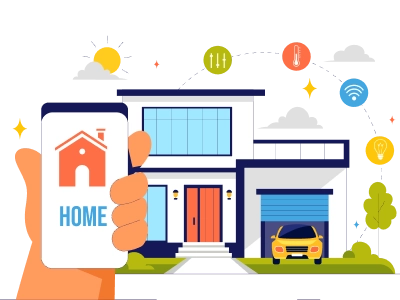Why Zillow’s Business Model Matters in 2025
Zillow changed the real estate game by digitizing property hunting and valuation. In 2025, this transformation continues as the platform holds over 50% of U.S. real estate portal market share and generates over $2 billion in annual revenue. For startups and entrepreneurs, exploring Zillow’s business model is vital — not to copy blindly, but to learn smart ways to tap into high-value real estate markets through technology.
This blog explores Zillow’s strategies, growth story, roadblocks, and how you can mirror its revenue engine by launching your own Zillow Clone App. Let’s dive in.
Zillow’s 2025 Market Dominance: Key Metrics & Growth Trajectory
User Engagement & Reach
- Zillow attracts over 230 million unique monthly visitors, leading the U.S. real estate market by a wide margin. (thunderbit.com, investors.zillowgroup.com)
- Average session duration ranges between 7–10 minutes—a strong engagement indicator.
Financial Snapshot
- 2024 Total Revenue: approximately $2.1 billion, with 2025 projected to hit $2.3 billion.
- Q2 2025:
- Revenue: $655 million
- Adjusted EBITDA: $155 million (~24% margin)
- Net income: $2 million GAAP profit (first since 2022). (barrons.com, onlinemarketplaces.com)
Revenue Breakdown
- Premier Agent Program: ~70%
- Rentals: ~18–20%
- Mortgage & Leads: ~5–7%
- Other (Display ads, data services): remaining share
Deep Dive: How Zillow Makes Money
Premier Agent Program (Advertising & Leads)
- Real estate agents pay Zillow for visibility on listings and buyer leads.
- It's a pay-per-lead model and remains Zillow’s most lucrative business stream.
- Insight for startups: similar models (premium listings, lead credits) can generate fast, recurring income.
Rental Listings & Landlord Services
- The rental vertical surged by over 30% YoY in Q2 2025, with multifamily listings up 56%.
- Tools like rent calculator, direct inquiries, and landlord dashboards drive engagement.
- Strategy tip: Provide landlord-focused tools (lease agreements, rent tracking) to add value and revenue.
Mortgage Marketplace & Financing Partnerships
- Zillow earns by routing mortgage leads and offers through partners—mortgage revenue rose as much as 41%.
- Opportunity: Even small real estate platforms can offer financing tools (calculator + lender integration) for affiliate commissions.
Display Advertising & Data Services
- Zillow's sheer traffic volume makes it a hotspot for home improvement, insurance, and moving services to advertise.
- Zillow also licenses its data (market stats, median home prices) to agencies and media.
- Lesson: Building rich data dashboards and spatial insights can unlock enterprise-level revenue.
Ready to Build Your Own Zillow-Like Platform?
Launch your real estate marketplace faster and smarter with White Label Fox’s ready-to-deploy Zillow Clone App. Scalable, customizable, and backed by expert support.

Behind the Scenes: Zillow’s Tech & UX Advantage
AI-Powered Zestimate
Zillow’s Zestimate offers instant home value estimates, powered by ML and real estate data. It’s both an engagement tool and a trust-building feature.
Interactive Map UI
Property maps allow brushing, zoning, and neighborhood overlays—boosting retention and discovery.
Mobile-First Design
With over 60% of Zillow usage on mobile apps, their user experience is optimized for small screens and seamless browsing.
Lesson for startups: Invest in intuitive design, AI estimations, and responsive layout—user experience directly translates to engagement and monetization.
Rising Challenges & Market Shifts
- iBuying fallout: Zillow’s once-promising iBuying model ended after a $200M+ write-down.
- MLS privacy trends: Pocket listings and commission caps are reducing Zillow’s dataset coverage.
- New competition: Platforms like Opendoor, Redfin, and NAR’s consumer portal challenge Zillow’s reach and revenue model.
- Ad-blocking: Increasing user use of ad blockers reduces display ad effectiveness.
Startup takeaway: Don’t rely on a single revenue stream—diversify, adapt, and leverage hyper-local data and UX to stay ahead.
Lessons for Startups: What You Can Replicate (and Avoid)
| Zillow’s Strength | Startup Strategy |
|---|---|
| Multiple revenue engines | Build with agent ads, rentals, mortgage tools, subscription tiers |
| Data-driven insights | Implement AI valuation or neighborhood heatmaps |
| Mobile-first UX | Prioritize app design; mobile drives engagement |
| Brand trust | Offer transparent data, verified listings, and clear processes |
| Diversification | Don’t lean on one source—expand into services and tools |
Red flags to heed: iBuying-style capital investment, building without a revenue-first mindset, or ignoring UX trends.
Architecting Your Zillow Clone App with White Label Fox
Highlights:
User App Features
- Quick onboarding, advanced search & filters, map search, listing details, virtual tours, favorites, calculator, chat.
Agent App Features
- Fast registration, multi-media listing uploads, lead management, notifications, listing control.
Admin Panel Features
- Dashboard analytics, agent approvals, property control, user management, payments, reporting.
Platform Availability
- Web + iOS + Android out of the box—consistent UX, easier maintenance.
Customization & Support
- White-label branding, modular features, scalable backend, plus 12 months of free support and updates.
This package gives startups everything needed to replicate Zillow’s model—fast, reliably, and affordably.
FAQs for Startups & Entrepreneurs
Conclusion: Why White Label Fox Gives You Zillow’s Advantage—Faster
Zillow’s 2025 model—with its diversified income, high engagement, AI-powered tools, and mobile-first UX—sets the gold standard. For startups, the path from concept to market-dominating platform doesn’t require reinventing the wheel.
With White Label Fox’s Zillow Clone App, you inherit Zillow’s revenue blueprint with far less risk and investment. Launch faster, brand stronger, and scale smarter. Your competitors are still building; you can live.
Let’s build your real estate success story today.

















